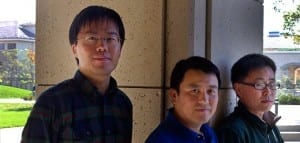
Could yield an entirely new class of devices that use light instead of electricity
Stanford researchers in physics and engineering have demonstrated a device that produces a synthetic magnetism to exert virtual force on photons similar to the effect of magnets on electrons. The advance could yield a new class of nanoscale applications that use light instead of electricity.
Magnetically speaking, photons are the mavericks of the engineering world. Lacking electrical charge, they are free to run even in the most intense magnetic fields. But all that may soon change. In a paper published in Nature Photonics, an interdisciplinary team from Stanford University reports that it has created a device that tames the flow of photons with synthetic magnetism.
The process breaks a key law of physics known as the time-reversal symmetry of light and could yield an entirely new class of devices that use light instead of electricity for applications ranging from accelerators and microscopes to speedier on-chip communications.
“This is a fundamentally new way to manipulate light flow. It presents a richness of photon control not seen before,” said Shanhui Fan, a professor of electrical engineering at Stanford and senior author of the study.
A DEPARTURE
The ability to use magnetic fields to redirect electrons is a founding principle of electronics, but a corollary for photons had not previously existed. When an electron approaches a magnetic field, it meets resistance and opts to follow the path of least effort, travelling in circular motion around the field. Similarly, this new device sends photons in a circular motion around the synthetic magnetic field.
The Stanford solution capitalizes on recent research into photonic crystals – materials that can confine and release photons. To fashion their device, the team members created a grid of tiny cavities etched in silicon, forming the photonic crystal. By precisely applying electric current to the grid they can control – or “harmonically tune,” as the researchers say – the photonic crystal to synthesize magnetism and exert virtual force upon photons. The researchers refer to the synthetic magnetism as an effectivemagnetic field.
The researchers reported that they were able to alter the radius of a photon’s trajectory by varying the electrical current applied to the photonic crystal and by manipulating the speed of the photons as they enter the system. This dual mechanism provides a great degree of precision control over the photons’ path, allowing the researchers to steer the light wherever they like.
BROKEN LAWS
In fashioning their device, the team has broken what is known in physics as the time-reversal symmetry of light. Breaking time-reversal symmetry in essence introduces a charge on the photons that reacts to the effective magnetic field the way an electron would to a real magnetic field.
For engineers, it means that a photon travelling forward will have different properties than when it is traveling backward, the researchers said, and this yields promising technical possibilities. “The breaking of time-reversal symmetry is crucial as it opens up novel ways to control light. We can, for instance, completely prevent light from traveling backward to eliminate reflection,” said Fan.
via Stanford University
The Latest Streaming News: Synthetic Magnetism updated minute-by-minute
Bookmark this page and come back often
Latest NEWS
Latest VIDEO









